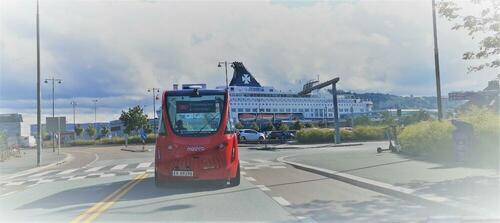The successful full implementation of automated shuttles in regular traffic will not be possible without a deeper understanding of their interactions with other traffic participants, according to studies conducted by researchers at the Institute of Transport Economics TØI. The automated shuttles are low speed, electric minibuses, currently operating mostly at SAE automation level 3 (i.e. there is a human operator presented on board, ready to take over operation if a situation requires it). There have been numerous deployment pilot projects of these shuttles carried out worldwide, typically in low speed environments (such as campuses, city centre districts or a national park) or at specific events (such as Olympic games). Obviously, safety is the biggest concern when implementing these shuttles into traffic.
In the period 2018 to 2021, thirteen automated shuttle pilot projects have been carried out in ten municipalities in Norway. These projects took place in variety of urban environments, such as a city centre, a sea promenade, a pedestrian zone and a residential area - typically places without any previous public transport services. The main goals of the pilots have been to test communication between the shuttles and a traffic signalling system, study the effects of the shuttles on travel behaviour of residents, evaluating the interactions between the shuttles and vulnerable road users, and testing the performance of the shuttles in winter conditions. One pilot was operated at automation level 4 in regular traffic (without a human operator on board), while the others were operated at automation level 3.
- TØI has been involved in four pilots so far. In these pilots we carried out external video observations with the goal of exploring the interactions between the shuttles and other traffic participants, also with a traffic signalling system, says TØI researcher Petr Pokorny.
He emphasized that these pilots have been carried out in regular traffic conditions on public roads, which provided a unique opportunity to study the shuttles’ operation and interactions in complex urban traffic.
- We identified several potentially risky types of behaviour, such as unexpected and abrupt stops of the shuttles in certain situations, or other road users dangerously overtaking or not giving way to the shuttles. As for the shuttles, the identified crucial technological and software challenges related to road safety were the correct interpretation of traffic situations and intensity of braking. Our findings show that the safety research must focus not only on the shuttles, but also on how other traffic participants perceive them, how they behave when encountering the shuttles, and why they behave in such ways, explains Pokorny.
More information is available in an longer article at toi.no that summarizes the safety knowledge TØI has gained from video observations in several Norwegian pilot projects, wherein the shuttles have been operating in regular traffic. The article also includes video clips with examples of studied interactions.
For more information about the project contact Petr Pokorny.






